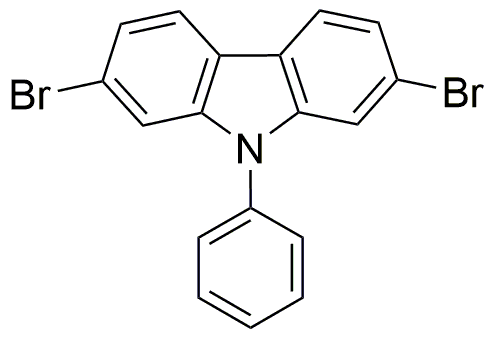2,7-Dibromo-9-phenylcarbazole is widely utilized in research focused on:
- Organic Electronics: This compound is used in the development of organic light-emitting diodes (OLEDs), providing enhanced efficiency and color purity compared to traditional materials.
- Photovoltaics: It serves as a key component in organic solar cells, improving energy conversion efficiency and stability, making it a valuable material for renewable energy applications.
- Fluorescent Dyes: The compound is employed in the formulation of fluorescent dyes for biological imaging, offering superior brightness and photostability for researchers in life sciences.
- Polymer Chemistry: It is utilized in synthesizing novel polymers with tailored electronic properties, aiding in the development of advanced materials for various industrial applications.
- Sensor Technology: This chemical is incorporated into sensors for detecting environmental pollutants, providing high sensitivity and selectivity, which is crucial for environmental monitoring.
General Information
Properties
Safety and Regulations
Applications
2,7-Dibromo-9-phenylcarbazole is widely utilized in research focused on:
- Organic Electronics: This compound is used in the development of organic light-emitting diodes (OLEDs), providing enhanced efficiency and color purity compared to traditional materials.
- Photovoltaics: It serves as a key component in organic solar cells, improving energy conversion efficiency and stability, making it a valuable material for renewable energy applications.
- Fluorescent Dyes: The compound is employed in the formulation of fluorescent dyes for biological imaging, offering superior brightness and photostability for researchers in life sciences.
- Polymer Chemistry: It is utilized in synthesizing novel polymers with tailored electronic properties, aiding in the development of advanced materials for various industrial applications.
- Sensor Technology: This chemical is incorporated into sensors for detecting environmental pollutants, providing high sensitivity and selectivity, which is crucial for environmental monitoring.
Documents
Safety Data Sheets (SDS)
The SDS provides comprehensive safety information on handling, storage, and disposal of the product.
Product Specification (PS)
The PS provides a comprehensive breakdown of the product’s properties, including chemical composition, physical state, purity, and storage requirements. It also details acceptable quality ranges and the product's intended applications.
Certificates of Analysis (COA)
Search for Certificates of Analysis (COA) by entering the products Lot Number. Lot and Batch Numbers can be found on a product’s label following the words ‘Lot’ or ‘Batch’.
*Catalog Number
*Lot Number
Certificates Of Origin (COO)
This COO confirms the country where the product was manufactured, and also details the materials and components used in it and whether it is derived from natural, synthetic, or other specific sources. This certificate may be required for customs, trade, and regulatory compliance.
*Catalog Number
*Lot Number
Safety Data Sheets (SDS)
The SDS provides comprehensive safety information on handling, storage, and disposal of the product.
DownloadProduct Specification (PS)
The PS provides a comprehensive breakdown of the product’s properties, including chemical composition, physical state, purity, and storage requirements. It also details acceptable quality ranges and the product's intended applications.
DownloadCertificates of Analysis (COA)
Search for Certificates of Analysis (COA) by entering the products Lot Number. Lot and Batch Numbers can be found on a product’s label following the words ‘Lot’ or ‘Batch’.
*Catalog Number
*Lot Number
Certificates Of Origin (COO)
This COO confirms the country where the product was manufactured, and also details the materials and components used in it and whether it is derived from natural, synthetic, or other specific sources. This certificate may be required for customs, trade, and regulatory compliance.


